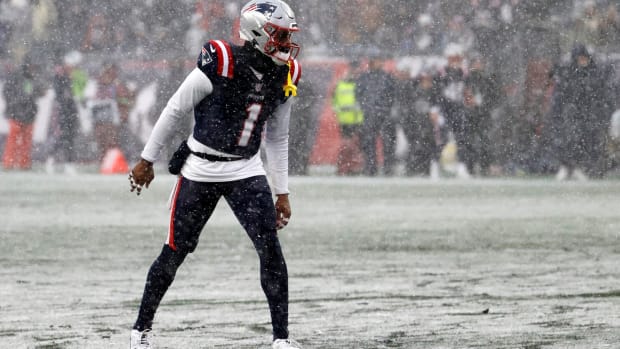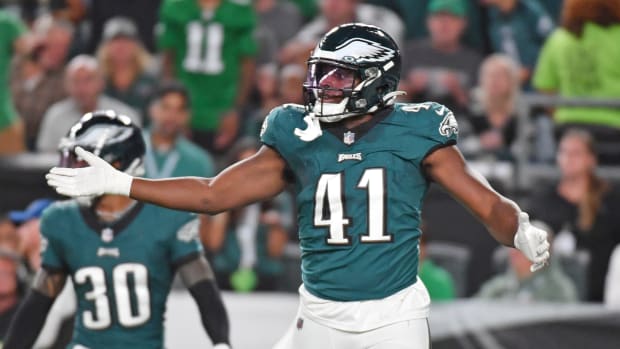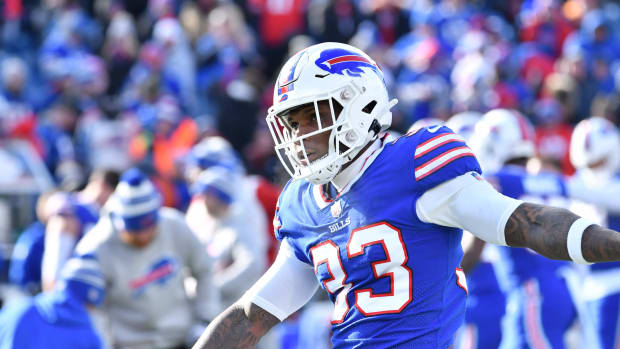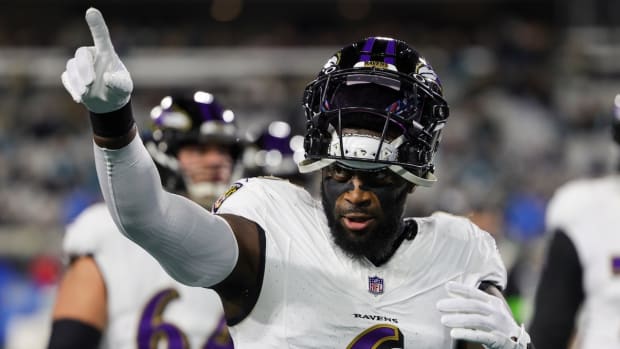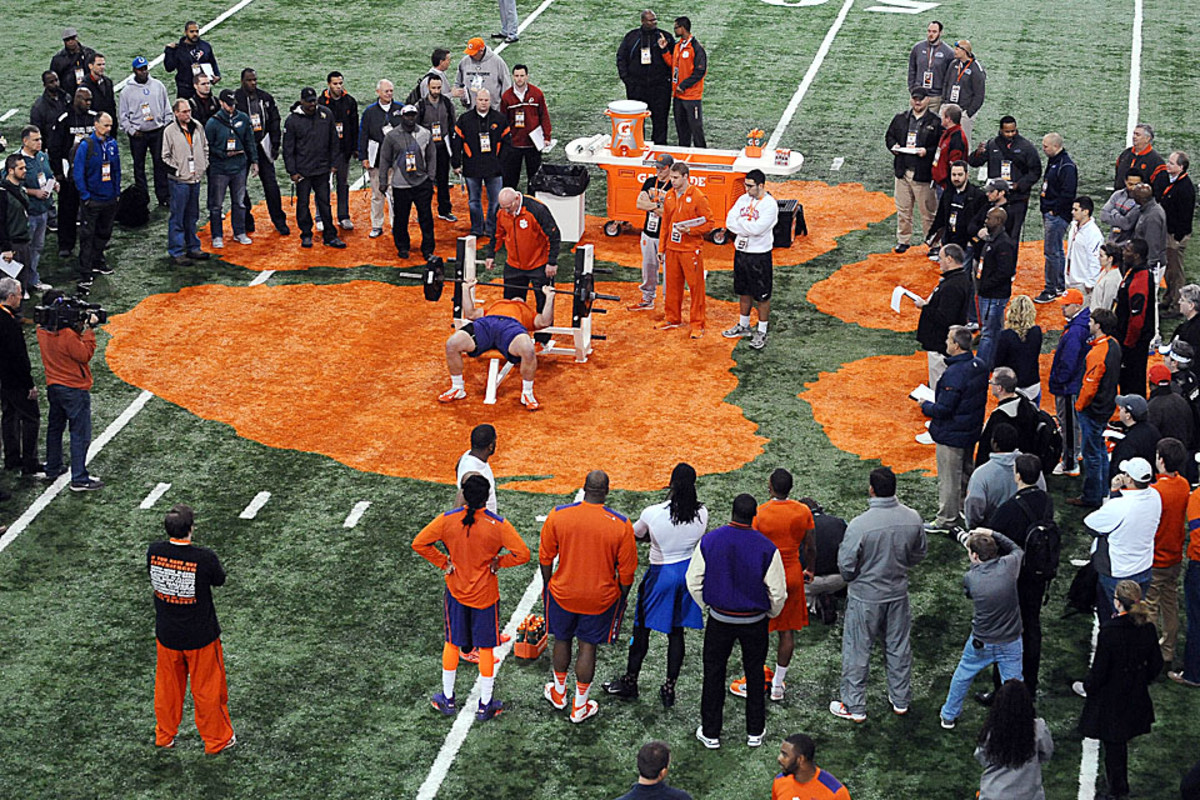
T-Minus 56 Days: What Pro Days Prove
Pro days are here. Texas A&M and Mississippi State were the headliners yesterday. Today it’s Clemson’s turn to showcase its talents for NFL personnel. Six members of Dabo Swinney’s standout defense were invited to the combine and will work out again today on campus. The Tigers led the nation in 11 major defensive categories, so what more do they have to prove?
“It’s funny,” Swinney says. “I was at the Senior Bowl and I was talking with a scout I’ve known for years about Stephone Anthony, one of our linebackers. And he said, Yeah, I’m not sure he can play Tampa-2. He looked like a 4.8 [40-yard dash] guy to me. And I looked at him like he was crazy.”
Anthony, a potential first-rounder, later ran a 4.56 40 at the combine. He’ll showcase his speed and agility again today.
“There was this perception that he’s not very fast, and I don’t know why,” Swinney says. “Everybody has their own opinions, and that’s why you have the combine and the pro day. A guy like Steph has the tape, and now he has the measurables, and he moves up the board. Now you can check all the boxes.”
That’s what pro days are about: checking the boxes. Any team interested in pass-rusher Vic Beasley saw him run a 4.53 40 and bench-press 225 pounds 35 times at the combine. They interviewed him and took a host of MRIs. Now they’ll get to run him through linebacker coverage drills because… why not?
Stephone Anthony will look to keep his draft season momentum going at Clemson’s pro day. (John Raoux/AP)
And then there are the rare players who are getting their first exposure to NFL teams at their pro days. (For whatever reason, they didn’t attend an all-star game or didn’t participate in the combine.) Twelve years ago, Arizona State pass-rusher Terrell Suggs was one of those players. Phil Savage, then the Ravens’ director of player personnel, was on hand to see him run a 4.9 40. Scouts groaned, but the Ravens were already in love after watching him in person during the fall.
“I remember driving back to the hotel and calling Ozzie [Newsome] and saying, We’re going to have a shot at this guy at 10,” Savage says. “It worked out for us because we knew we wanted him, and the last vision everybody had of him was him not running fast.”
The Ravens took Suggs with the 10th pick, and he went on to six Pro Bowls and a Defensive Player of the Year award in 2011.
“The film is going to be your biggest measurement,” Swinney says. “After that, they want to see you go through their specific position drills. They want to spend more time with you and try to figure out what kind of person you are.”
Swinney has a tradition at Clemson: Players are cycled through a large meeting room filled with dozens of NFL personnel and asked to give a statement. Then there’s a Q&A. Anybody can raise his hand and ask any question. Just like press conference day at the combine, but way scarier.
What’s more, Swinney says, “You have the added pressure of all the exposure, with NFL Network being there. Back when I was coming out”—Swinney was a wide receiver at Alabama in the early ’90s—“you didn’t have everything these guys do or say being recorded and talked about. You didn’t have all the agendas.
“There’s more pressure on these guys right now than at any time.”
Five Things You Need To Know About The Draft
The five prospects facing make-or-break pro days or private workouts, and what Savage thinks of each of them...
Shane Ray, DE, Missouri (March 19)
Perhaps the highest-rated prospect who didn’t work out in Indianapolis, Ray skipped the proceedings because of a foot injury but plans to do it all on the 19th. He’s in the top-10 conversation because of his edge rushing credentials, but the big question is whether the 245-pounder can satisfy in pass-coverage drills.
Phil’s take: “He’s at the top of my list, just because he’s an underclassman, no all-star games, no combine. All the eggs are in one basket for his pro day. You think you know what a player is going to be, but you need that confirmation with the numbers. He’s also in that tweener category, so people want to know if he can stand up [as a linebacker].”
The Prospects
Marcus Mariota: The Oregon QB's game is being scrutinized more than any other prospect's.Lynden Trail: The draft's biggest mystery man comes from little Norfolk State.T.J. Clemmings: A switch from defense to offensive tackle awakened a monster.Shaq Thompson: Before he was an NFL prospect, he was baseball's worst player.
Garrett Grayson, QB, Colorado State (March 23)
He’s the least-known commodity among the three quarterbacks vying to be chosen after Jameis Winston and Marcus Mariota. Grayson played in a pro-style offense under Jim McElwain, whose success with Grayson vaulted him to the Florida job. Grayson pulled a hamstring in February; he didn’t participate in combine drills and won't take part in Colorado State's March 11 pro day, to give the injury more time to improve. He'll instead work out on his own for scouts on March 23.
Phil’s take: “People need to see him live, but I’ve already had a number of scouts tell me they like him better than Bryce Petty and Brett Hundley.”
Breshad Perriman, WR, Central Florida (March 25)
The knock on the junior wide receiver is inconsistent and unpolished route running, as well as a tendency to disappear during games. How much have the mechanics improved out of season? And does the inconsistency boil down to personal inadequacies or the result of UCF’s overall struggles in the passing game a year ago?
Phil’s take: “The school was scouted, but it was probably scouted by your area scouts and not necessarily your front office at any point. He’s a bit of a mystery man.”
Marcus Peters, CB, Washington (April 2)
Peters is back in good graces with the program after being dismissed from the team for disciplinary issues in November. NFL folks will take this opportunity to see him deal with former coaches, take coaching on the field, and get a feel for his athleticism after a short hiatus from the game. Linebackers Shaq Thompson and Hau'oli Kikaha (the latter didn’t run at the combine) are also headliners.
Phil’s take: "This is not a great corner class, so people are really desperate to find a first-round-level talent, but when you get dismissed from a program, that’s a huge red flag. I’m sure some of those questions were answered at the combine, but it’s hard to do in a 15-minute interview.”
Tevin Coleman, RB, Indiana (April 15)
The man played through a foot injury that required surgery and still needed only 264 carries to reach 2,000 yards last season (he finished with 2,036 on 270 carries). That surgery kept him out of the combine, and he’ll do an individual pro day on April 15, two weeks after Indiana’s team workouts on March 30. Coleman is most effective as an outside runner with a lot of burst in and out of cuts. Can he replicate that explosiveness post-surgery and solidify himself as a second rounder?
Phil’s take: “There are a lot of blanks to be filled in. Very few people have seen him live. He’s got a good reputation and was productive on an average team when everyone on defense was concentrating on him.”
Photo by Brian Kersey/Getty Images
Draft Season Do-Over
Every week, we’ll ask a current NFL player what he would have done differently in the time between his final collegiate game and the day he was drafted…
Chicago Bears G Kyle Long (2013, 20th overall). “I’m sure a lot of guys would say they wish they’d taken it more seriously or studied more film. I would say that I have no regrets, but in my heart of hearts I know that I could’ve made myself a couple more million dollars had I really done it right my last year at Oregon. I thought I’d have another year of eligibility, so I was waiting for an NCAA ruling after the Fiesta Bowl. I really thought I was going to be able to play again, so I didn’t take senior year real seriously. I was kind of lackadaisical about the whole thing. I was like, It's my first year of real college. I’m going to show people a few flashes of athleticism to get them excited for next year.”
Better Know a Prospect
Photo by Rick Scuteri/AP
It’s high on the list of worst-case scenarios for a prospect in the age of marathon pre-draft evaluations: a nasty lower body injury in your final game as an amateur. It happened to Randall Telfer. In USC’s Holiday Bowl win over Nebraska, the tight end and projected sixth-rounder fractured his foot, requiring surgery. He wasn’t available for combine running drills, but that doesn’t mean Indy was a cakewalk. One night early in the week, Telfer was scheduled for an 11 p.m. MRI session but didn’t get back to his hotel room until 3 a.m. That morning there was a 6 a.m. wakeup call for bench press day.
“It wasn’t ideal, only sleeping a few hours, but I’m not going to make excuses,” he says. “You just deal with it.”
Just deal with it might as well have been the mantra of Telfer’s five years at Southern Cal. He was recruited by Pete Carroll, who left for the Seahawks before Telfer played a down for the Trojans. The NCAA hit USC with scholarship limits and banned the program from the postseason in 2010 and ’11, his first year on the field. Telfer played through the regimes of Lane Kiffin, Ed Orgeron and Steve Sarkisian and battled knee injuries the last two seasons. Despite Sarkisian’s assurances he’d be a weapon on offense as a redshirt senior, he took on a blocking role and caught only 21 passes and two touchdowns. And yet with each new coach and each letdown, Telfer and the Trojan elders who were among Carroll’s last recruiting class toed the company line and kept order in the locker room.
“What we would try to do is get the guys to buy in and understand that you play for the logo on the helmets, not the coach,” Telfer says. “It was about little things, like showing up to workouts on time. Fortunately for us, guys bought in quickly.”
Telfer caught 65 passes for 648 yards and 12 touchdowns over his career. At the combine he weighed in at 6-foot-4, 250 pounds, and bench-pressed 225 pounds 20 times. In a bold move for a likely Day 3 pick, Telfer brought a notebook and pen to every one of his interviews, armed with his own interview questions.
“I had some questions for teams, like what kind of tight end do you think I am, and how would I fit in your offense,” Telfer says. “It helps to write that stuff down.”
He won’t be ready for USC’s March 11 pro day, meaning NFL teams will have to trust what they see on tape over four years of football. What a novel concept.
Quote of the Week
“I think it's so funny how Mel Kiper is just ‘qualified’ to talk about the draft... dude be wrong with just about everything though... of course anybody can say anything about a ‘can't-miss’ prospect like Clowney or Peyton Manning or something like that... but he was wrong about Ray Lewis, he was definitely wrong about me... He has his favorites, and it's just crazy that people listen to that dude… him and his buddy Todd McShay...no way they watch legitimate film on all the prospects and can understand the way to compare and contrast.”
—Steelers running back Le’Veon Bell, an All-Pro in his second season
I think there are a lot of players who feel this way about draft analysts, and a sports psychologist will tell you a good chunk of professional athletes motivate themselves by harping on perceived slights. McShay and Kiper are easy targets because of their television platforms, so you'll hear a handful of non-first round picks such as Bell slam them during draft season. He ought to have a bigger beef with the 32 teams that passed on him in the first round, including the one that took him 48th overall in 2013.
Stat of the Week
If you don’t pay attention to college football you might be surprised to learn just how few defenses use press coverage.
In Florida State’s CFB playoff loss to Oregon, Jameis Winston faced some form of press coverage only four times.
Draft Projections
NFL film breakdown maven Andy Benoit and college football expert Andy Staples combine their knowledge to peg which prospects fit best with which teams. AFC East: A QB to Gang Green? A new Wilfork in New England?AFC North: A new target for Flacco? A pass-rusher joins the Steel Curtain?AFC South: This is where the running backs could go wild.
It would be a mistake to suggest that college teams don’t press. UCLA, for instance, pressed its corners on about half of Marcus Mariota’s pass attempts when they played last season. But college quarterbacks don’t face it nearly as often as they will in the NFL, and when teams like UCLA do flash the bump and run, passers look immediately to other receiving options. So why don’t college teams press as often as NFL teams, and how does that affect the evaluation process for quarterbacks? For perspective, I rang Ken Zampese, Bengals quarterbacks coach since 2003.
“It’s one of those things you don’t think about actively, but it’s in the back of your mind," he said. "To answer the first question, I think you have too much no-huddle in college to have your corners do all that running every play. They won’t last. Also, there’s this defensive philosophy in college of keeping everything in front of you and making them snap it until they screw it up.”
So quarterbacks rarely see bump and run until they get to the NFL, which means they’ve rarely (or never) thrown a quick slant without five yards of cushion, or a fade route requiring perfect, over-the-shoulder placement.
“Your rookie has never had to wait that extra tick for the guy whose route got thrown off," Zampese says. "It makes the evaluation tough. You have very little way of knowing if your guy has improvisational skills and poise when the route timing changes.”
It’s the kind of thing that’s not often discussed, but may help explain why such a small percentage of college quarterbacks make a smooth transition to the pro game.
Inexact Science
As you pore over the scouting reports in advance of the draft, remember to take them with a grain of salt. Here’s ESPN the Magazine’s assessment on its eighth-rated defensive end, a Louisville product, in 2006:
“Poor height, so some tackles will just engulf him. Unable to hold his ground consistently when opponents run at him. Shows mediocre recognition skills and doesn’t change directions as fluidly as elite NFL DEs. Gets too far upfield at times and struggles to immediately redirect.”
The prospect? Two-time All-Pro Elvis Dumervil, selected by the Broncos in the fourth round.
Scorching Hot Take of the Week
This week, it’s a tie...
And...
I once read Michael Vick described as “inconsistently spectacular and spectacularly inconsistent.” That’s how I feel about Twitter most days. I think it’s a place where a lot of us writers just throw something against a wall and hope it sticks. I’m not suggesting Mr. Domowitch or Mr. Fischer don’t know their stuff. They do. And I’m not suggesting either of them aren’t plugged in. They are. Here’s the problem: Only a handful of people know what Chip Kelly is going to do over these next few weeks, so why speculate unless you’ve got some sourcing behind it? And even if you have someone in your ear, you have to suspect anything that leaks about draft strategy has been deliberately shared as an attempt to mislead other teams.
Let’s focus on what we know. The Sober Take of the Week…
Follow The MMQB on Facebook, Twitter and Instagram.
[widget widget_name="SI Newsletter Widget”]










































